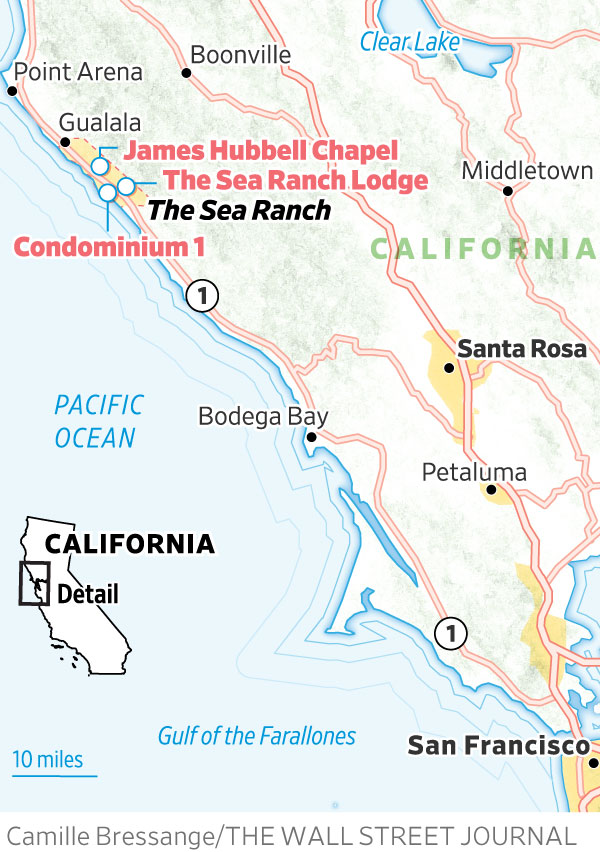The Pacific Ocean roils below, splashing hard against the cliff base. But high above the water, an enclave of homes clusters in placid harmony with nature.
Located three hours north of San Francisco, The Sea Ranch, an unusual hamlet of 1,788 modernist homes, was established in the 1960s as a second-home community. Fiercely private and environmentally conscious, the community has sought-after, innovative homes built by a dizzying array of architects. Preserved land stretches between houses to ensure open space and room for the architecture to breathe, while strict design guidelines ensure that new housing adheres to the vibe.
“There’s no place like this anywhere,” says general contractor Ralph Jackson, 77, who estimates that he has built about 70 Sea Ranch homes since arriving in 1968.
Homes in the community don’t come cheap. Currently, there are about seven homes on the market ranging from $930,000 to $8 million. The most expensive home ever to sell in The Sea Ranch was the home of landscape architect Lawrence Halprin, which went for $12 million in 2021, according to local real-estate agent Hanne Liisberg. She says her business quadrupled during the pandemic: “We’d get 15 offers on a listing, which we weren’t used to.” Now the pandemic frenzy is largely over. Only 29% of the homes sold in The Sea Ranch in the last six months received multiple offers, according to broker Kristen Winant.
It isn’t an easy task to reach this unincorporated community. Getting there requires driving along Highway 1 amid a scene so beguiling—waves crashing on the rocks below a road without guardrails—that you can’t look away, but you must because there is no shoulder. The nearest hospital is about two hours away. There is no mail delivery or grocery store. To pick up mail from a post office box, residents go to The Sea Ranch Lodge, a historic hotel and restaurant, or drive roughly 10 miles to the town of Gualala, where they also get groceries. The community’s offerings do include hidden waterfalls, tide pool beaches, a private airstrip, a golf course and a circa-1880 barn where The Sea Ranch Thespians perform. The area was once used as a sheep ranch; sheep still graze behind rustic fences.
The Sea Ranch came into being in 1963, when the architect and developer Al Boeke purchased a roughly 10-mile strip of coastline with plans to build a progressive community with other architects, many of whom taught at the University of California, Berkeley. Halprin, inspired in part by his time on a kibbutz in Israel, created the utopian master plan.
The original architects considered making The Sea Ranch look like a Greek town with white stucco homes, but changed their minds, opting instead for modern architecture intended to blend into the landscape, according to resident Scott C. Nevin, a software engineer who is on the board of The Sea Ranch Association. The association manages everything from community affairs to land-use and design restrictions to issuing parking permits, since unregistered visitors aren’t allowed on the community’s private roads.
Condominium 1, the first occupied building in The Sea Ranch, is now on the National Register of Historic Places. It was designed by architectural firm Moore, Lyndon, Turnbull and Whitaker, sometimes called MLTW. At the time, condominiums were a relatively new form of ownership, says Donlyn Lyndon, the “L” of MLTW, who has lived in The Sea Ranch on and off over the years and was the first chair of the commons landscape committee. “People were nervous because they didn’t know what it meant” to live in a condo, says Lyndon, now 88, who has designed about eight homes in The Sea Ranch. “They might get stuck in this building with others.” A second condominium was built somewhat later. Today The Sea Ranch has a total of about 14 condo units, which typically sell for $900 to $1,800 a square foot, according to Liisberg.
Also at the outset, the architecture firm of Joseph Esherick & Associates designed “hedgerow houses,” which were grouped in the existing hedgerows to leave meadowland untouched and sea views open to all. Then architect Obie Bowman designed walk-in cabins, which are located away from parking areas and accessible via a foot trail through the wooded hillside; to this day, new homes in The Sea Ranch are built with fencing to hide cars and trash bins. Cluster houses designed by architect William Turnbull formed the next round of housing, placed closely together and yet adjacent to large swaths of undeveloped land with hiking trail access. Finally, single-family homes were designed by any number of architects. All were created with the idea of “living lightly on the land,” and The Sea Ranch Association continues to stave off what it calls “creeping suburbanism.”
The artist James Hubbell organized local artisans to add a curved wood-and-stone chapel, completed in 1985. An asymmetrical structure that looks like Joan of Arc’s helmet, it was built over nine months from a model without official construction plans. Inside the nondenominational space, jewel-toned stained glass illuminates redwood seating and wood embedded with seashells.
The Sea Ranch began as a weekend retreat for architects, designers and artists from the Bay Area. “Everyone used to dance naked on the beach,” says Nevin. “It was a bunch of hippies that settled this place. I’ve heard crazy stories.”
Despite the community’s progressive bent, “we didn’t ever see it as a commune,” says Lyndon, whose assistant, Susan Quinn, calls him The Patriarch of The Sea Ranch. “We saw it as a place to live on the edge of the ocean.”
Today, about a third of homeowners live in the community full time, another third rent out their properties, and the rest use them as weekend or vacation homes. The pandemic brought in a lot of tech people from the Bay Area, according to Liisberg. A few years ago, The Sea Ranch Lodge was purchased by a group including Patrick and John Collison , co-founders of the payments giant Stripe, along with venture-capitalist Robin Chan and Justin Kan , co-founder of the video livestreaming platform Twitch, according to people familiar with the matter.
Lyndon and his wife, artist Alice Wingwall, live in a residence in The Sea Ranch he designed around 1992. They bought the land in 1990 for $33,000, according to property records, choosing this piece of property in part because of a significant boulder in the yard. “The upthrust of land and collection of geologic processes reminds us that we’re very new to this place,” Lyndon says. His studio in the home has bookshelves, flat files of architectural plans, and a George Nelson table brimming with the five books he authored, including “The Sea Ranch” with photographer Jim Alinder.
Polly Bove, 75, a retired school superintendent, lives full time in The Sea Ranch, where she has owned three different houses over the years. She first visited for a camping trip in 1972. “I could not stop looking at the stars, and then I just never stopped.”
Bove bought her first house in The Sea Ranch in 2002 for $486,000, selling it two years later for $1.2 million. She and general contractor Jackson, who has worked with her on previous homes, bought her current house in 2020 for $1.7 million. She spent about $1.2 million renovating the circa-1984 house, removing a wall that blocked the ocean view from the kitchen and installing vertical grain fir walls, a signature of The Sea Ranch. The home’s entry is through a courtyard with ponds filled with pedigreed koi she rescued. The hillside home offers dramatic views of the ocean; she sees migrating whales from her deck. There’s a spring that attracts animals, from deer and quail to bears drawn to the huckleberries.
Bove bought the house thinking it could be an extended family compound, but a smaller home in The Sea Ranch is now her goal. She previously had the house on the market for $4.5 million, and plans to put it back on for that price.
The community’s smaller, original post-and-beam structures are highly desirable and sell faster and for more money than larger, later homes, Liisberg says. In the past six months, 34 homes sold in The Sea Ranch for an average cost of about $1.5 million, according to Winant. Of those, only one was post-and-beam, “and a beautiful specimen at that,” Winant says; it went for $2.11 million.
Renovating or building a home in The Sea Ranch can be a long process due to its stringent design guidelines, in addition to the community’s covenants, conditions and restrictions, or CC&Rs. “There are CC&Rs, bylaws and rules,” says full-time resident Linda McCabe, 60, a laboratory technical consultant. It can take anywhere from at least a year to two years to get design approval.
Married architects Doug and Marilyn Thompson, who live full-time in The Sea Ranch, are poised to significantly renovate their 1979 home, adding a new kitchen, primary suite, garage and courtyard. They purchased the roughly 1,000-square-foot home in 2021 for $1.1 million, and say that big projects like this usually go through three to six design-committee review meetings, each about three months apart, beginning with sharing sketches. The process addresses issues like honoring neighbors’ view corridors. Committee members have a vast knowledge of The Sea Ranch, says Doug, 67. “If you’re smart, you’re using them as a resource, not a hurdle.”
Doug likens The Sea Ranch to “a wonderful Italian hill town where the whole community has an architectural integrity everywhere you look, that consistency that permeates everything,” he says. “It doesn’t mean it’s all the same. There is just a certain appreciation to place-making.”
Previously, the Thompsons owned a 567-square-foot, 1973 walk-in cabin, which they bought in 2019 for $475,000. “These walk-in cabins were developed before ‘tiny homes’ became a thing,” says Marilyn, 65. “They’re just a simple little shape in the redwoods.” After trying to live in the house full time, they found it too small, and sold it in 2021 for $725,000.
McCabe first visited The Sea Ranch for a weekend retreat and was enchanted. She brought Nevin, her husband, to see it, and “he started fixating on how we could live here.” In 1999, they purchased land for $60,000. They later sold their five-bedroom home in Windsor, Calif., to finance construction of a two-bedroom home in The Sea Ranch, completing in 2021 after 16 months.
The design-review process required three meetings. “We hired Bob Hartstock, who has done houses here for 30 years,” says Nevin, 60. “He knows the vernacular and he’s not going to push the boundaries.” The couple spent about $800,000 on the project.
“How many places can you sit on your patio and you can hear the wind going through a bird’s feathers?” asks Nevin. “It’s so quiet. You have the Milky Way sitting over you while you’re having dessert. I literally go to tears at the stark beauty of the place I’m able to live in.”
— Angel Au-Yeung contributed to this article.



